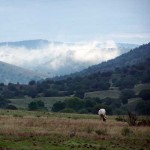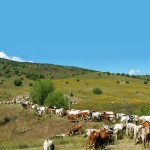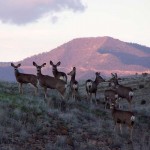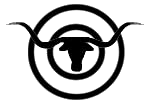
A lone steer grazes, oblivious to the view behind him.
Rotational grazing sounds like a quick way to make a cow dizzy, but in fact it’s an extremely effective way to manage pastures and range land and improve both the production and quality of forage!
Just like people, cattle have favorite foods. Left to their own devices, cattle will first eat all the choicest grasses. When those are gone, they tend to stay on the same spots, eating the tender new shoots again and again, never allowing the plants to recover. Meanwhile, they completely ignore the less choice plants, which dry out and oxidize, losing their nutrients to the atmosphere rather than being recycled into the ground.
This cycle of overgrazing good grass and undergrazing the rest diminishes the energy the land can produce, lowering the quality of soils and grasses and decreasing overall forage production. Pastures that are severely undergrazed—or worse, left completely ungrazed for the season—become tremendous fire hazards, full of dry, woody tinder.
With rotational grazing, our land is divided into dozens of pastures and our cattle spend a carefully controlled period of time in a pasture before being moved to the next one. Depending on the size of a pasture and the amount and condition of forage it contains, our herd may be moved onto a new pasture after as little as a few days. By moving them constantly, no pasture gets over- or undergrazed, and we are able to utilize the entire ranch.
Overgrazing
Forage needs to have time to rest after it has been grazed. If we allowed the cattle to overgraze they would keep their favorite plants constantly munched down, which places great stress on the roots and ultimately damages the plant. We are fortunate to have so much land to spread out in, so after our herd has been on a pasture it is typically not grazed again for the rest of the year. (Sometimes we rest as pasture for as long as three years. It all depends on what each particular pasture needs.)
Undergrazing
Most people assume overgrazing would be the bigger problem where a herd of cattle is concerned, but in fact undergrazing is just as bad and sometimes even worse. Undergrazed areas become fibrous, with old, woody, low protein plants instead of the fresh, green salad that cattle as well as native wildlife prefer. By herding our cattle into all areas of the ranch, we can avoid plants becoming fibrous and choking out young growth.
When to move the cattle

The herd moves to its next buffet
As a very rough estimate, a 1,000 pound steer requires approximately 20 pounds of forage a day, or 2% of its body weight. We can look at a field and gauge the amount of forage it contains in terms of both density and height of grass per acre, and estimate fairly accurately how many cattle can graze for how many days without harming the grass in that area. Similarly, once the cattle are on a pasture, we pay close attention to what is happening in it from day to day, so we know the moment a pasture has hit its optimum point of grazed enough but not overgrazed. This is the time to move the steers to their next buffet.
Monitoring what’s in a pasture
Basically, with rotational grazing we are managing our forage instead of just managing our cattle. We spend a lot of time moving our herd from pasture to pasture, but we spend just as much time measuring our fields and evaluating their health and stamina. We go into a field to monitor its quality both immediately before and immediately after the herd is on it. Monitoring is a scientific metric that quantifies what’s happening in the pasture, both today (Do the steers have sufficient water? Is the grass gone earlier than expected?) and long-term (Is the plant variety increasing or decreasing? What’s happening with the soil moisture content?). There are guidelines around where specifically to monitor—not too close to a water source or bedding area, for example—and we always monitor the same areas of each pasture in order to see what the multi-year trends are on the land.
For example, simply noting that a perennial grass appears one year in a pasture doesn’t tell us much…maybe last year there were twice as many! Likewise, seeing weeds or sagebrush doesn’t necessarily mean the land is unhealthy…maybe last year the soil was so poor it couldn’t support any vegetation at all, so the weed is in fact a good sign. The only way to know for sure is by looking year after year at the same fixed points, charting the information, and analyzing the results.
The monitor takes one hundred paces, documenting at every step what is under his or her feet: specifically what kinds of grasses, are they green or woody, is there old manure from past use of the field, are there signs of increased wildlife use of the field since it was grazed. Every third step, a small ring is set down and all the grasses within the ring are clipped at ground level and bagged for analysis back at the ranch.

Mule deer, antelope and elk often graze alongside our herd of Longhorn steers.
It takes a while to begin to see the usefulness of monitoring every pasture, before and after it is used, but in time it becomes a tremendous tool. We have many years of records, all documenting the quality of the land. We can look at a pasture that has taken a hit, and go to our records to figure out why: did we leave the cattle on it too long? Not long enough? Was there a severe drought? Fire? All these things come out in our monitoring records, which we also provide to various environmental organizations and government agencies as a matter of public record.
Trends
Since we have been practicing rotational grazing, the range land at the Double Circle Ranch has improved dramatically. It is a long-term program with long-term benefits, and looking at our monitoring records over the years, it is very clear that rotational grazing has gradually increased our forage quality and quantity, prevented soil erosion and even reversed it in worn areas, and greatly improved the quality of our land as a whole. University studies and government agencies alike have agreed that rotational grazing not only prevents the damage often associated with ranching and cattle management, but done properly, can actually leave the land in better condition than if it never had cattle on it at all.
The Double Circle Ranch is working hard to become an example of how properly managed cattle can improve the land and the environment, and to dispel the stereotypes and misconceptions many people have about cattle ranching. It is not only possible to maintain large herds of cattle without ever over- or undergrazing the land, but to turn the herd into a useful conservation tool to improve rangeland. We are extremely proud of our documented record of improving the land with rotational grazing. Come out and visit us and we’ll show you what we mean!


